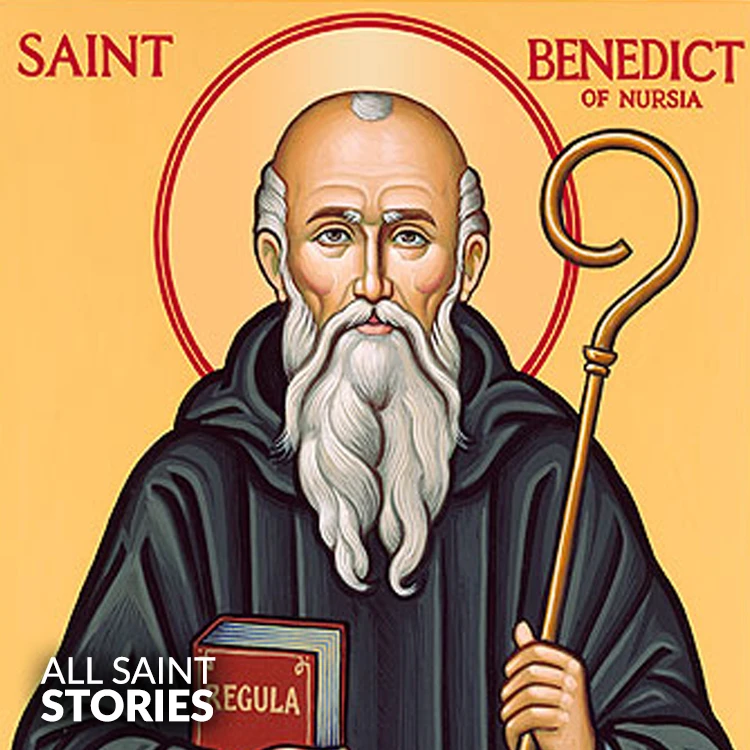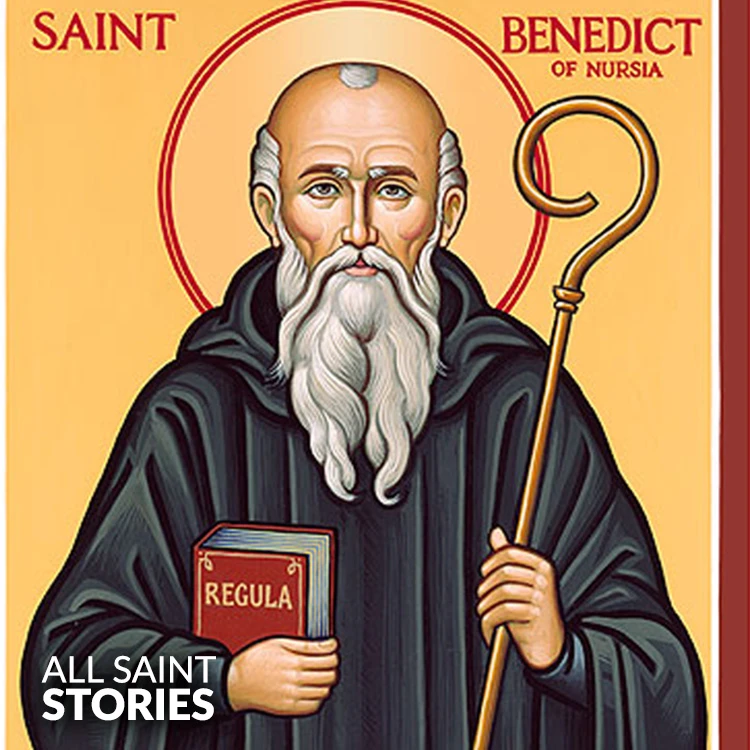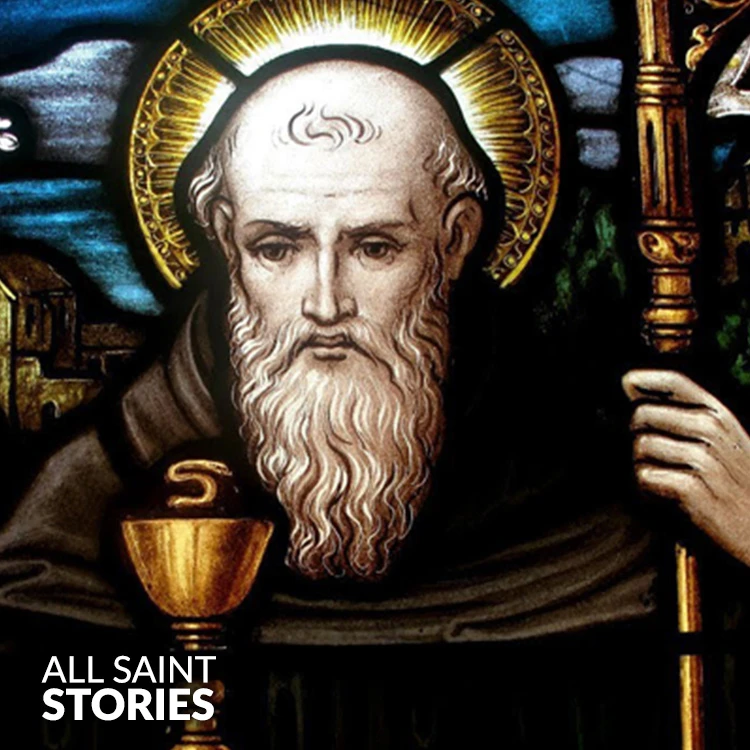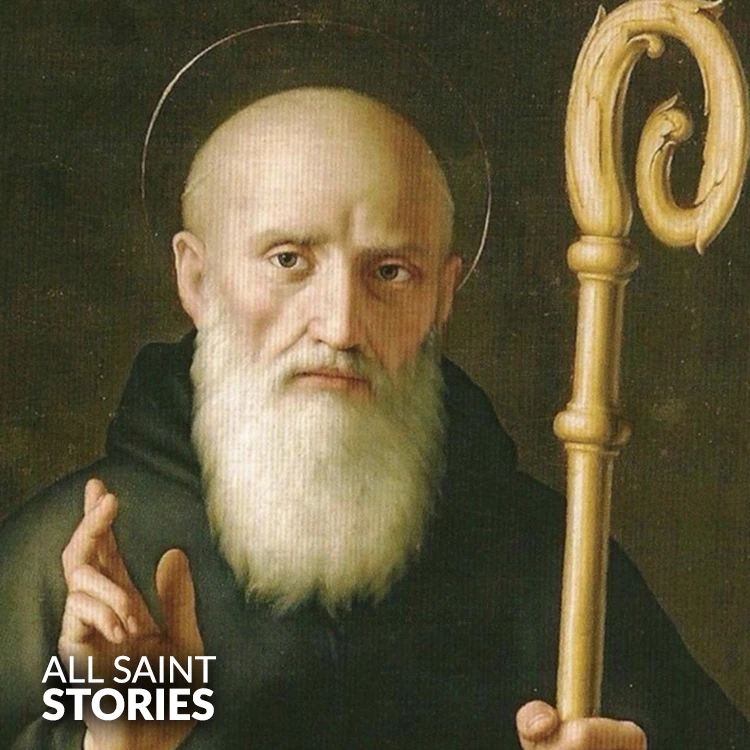"Saint Benedict, protector against evil and temptation, intercede for us before the Lord. Grant us strength to resist the enemy, peace in our hearts, and faith in our lives. Through your holy prayers, may we be led closer to Christ. Amen."
ST. BENEDICT (480-543)
ST. BENEDICT (480-543)

Benedict of Nursia, born in 480 in Italy, was the founder of Western monasticism and the Benedictine Order. Leaving Rome for a life of solitude, he lived as a hermit before establishing monasteries, including Monte Cassino. His Rule of St. Benedict shaped monastic life with its balance of prayer and work. Known for his miracles and spiritual guidance, he passed away on March 21, 547. Today, he is venerated as the patron saint of Europe, with a legacy that continues to influence religious communities worldwide.
Benedict's life is mainly documented through Pope Gregory I's second volume of his Dialogues, written in 593, though the authenticity of this work is debated. Gregory's portrayal is more of a spiritual image of Benedict than a detailed biography, as he chose to focus on specific miraculous events through firsthand accounts from Benedict’s disciples, including Constantinus, Honoratus, Valentinianus, and Simplicius.
Gregory didn’t set out to write a chronological history but instead presented a collection of stories about Benedict, emphasizing his holiness and miracles. Gregory’s approach was more theological, using these narratives to highlight moral and spiritual lessons rather than providing a detailed historical account.
Benedict, born around 480 in Nursia (modern Norcia, Italy), was the son of a Roman noble. He is often believed to have been a twin with his sister Scholastica. He was sent to study in Rome, but disillusioned with the lifestyle he encountered there, he withdrew from the city. He lived in Enfide, possibly modern-day Affile, and later moved to Subiaco, where he spent three years in seclusion, living in a cave. During this time, he received guidance from the priest Romanus, who brought him food and spiritual counsel.
Benedict’s early years as a hermit were marked by supernatural events that began to spread his reputation. The monks of a nearby community, facing challenges with their leadership, invited Benedict to become their abbot. After a series of attempts to harm him, including poisoned food and drink, Benedict left the monastery and returned to his cave in Subiaco.
Around 530, Benedict founded the great Benedictine monastery at Monte Cassino, where he would spend the remainder of his life. He is said to have died on 21 March 547, possibly from a fever, and was buried at Monte Cassino alongside his sister Scholastica.
In his writings, Benedict established the Rule of St. Benedict in 516, which became a foundational guide for monastic life. The Rule emphasizes a balanced life of prayer, work, and study, encapsulated in the motto "Ora et Labora" (Pray and Work). This balanced approach has influenced countless monastic communities throughout history.
St. Benedict is the patron saint of Europe and is remembered on 21 March for his death, though his feast day was moved to 11 July in 1969. The Benedictine medal, bearing symbols of his life and miracles, is widely used as a protection against evil, featuring inscriptions and prayers for strength and defense against temptation.
Benedict’s influence extends beyond monasticism. His Rule is not only a spiritual guide but also a practical framework for community living, emphasizing obedience, humility, and stability. The Benedictine tradition has had a profound impact on Christian life and culture throughout the centuries, and St. Benedict’s legacy continues to inspire both religious and lay communities today.
Video Not Found
The information on this website is compiled from various trusted sources. While we aim for accuracy, some details may be incomplete or contain discrepancies.
If you notice any errors or have additional information about this saint, please use the form on the left to share your suggestions. Your input helps us improve and maintain reliable content for everyone.
All submissions are reviewed carefully, and your personal details will remain confidential. Thank you for contributing to the accuracy and value of this resource.
Credits & Acknowledgments
- Anudina Visudhar (Malayalam) – Life of Saints for Everyday
by Msgr. Thomas Moothedan, M.A., D.D. - Saint Companions for Each Day
by A. J. M. Mausolfe & J. K. Mausolfe - US Catholic (Faith in Real Life) – Informational articles
- Wikipedia – General reference content and images
- Anastpaul.com – Saint images and reflections
- Pravachaka Sabdam (Malayalam) – Saint-related content and insights
We sincerely thank these authors and platforms for their valuable contributions. If we have unintentionally missed any attribution, please notify us, and we will make the correction promptly.
If you have any suggestion about ST. BENEDICT (480-543)
Your suggestion will help improve the information about this saint. Your details will not be disclosed anywhere.
© 2025 Copyright @ www.allsaintstories.com




 English
English
 Italian
Italian
 French
French
 Spanish
Spanish
 Malayalam
Malayalam
 Russian
Russian
 Korean
Korean
 Sinhala
Sinhala
 Japanese
Japanese
 Arabic
Arabic
 Portuguese
Portuguese
 Bantu
Bantu
 Greek
Greek
 German
German
 Dutch
Dutch
 Filipino
Filipino